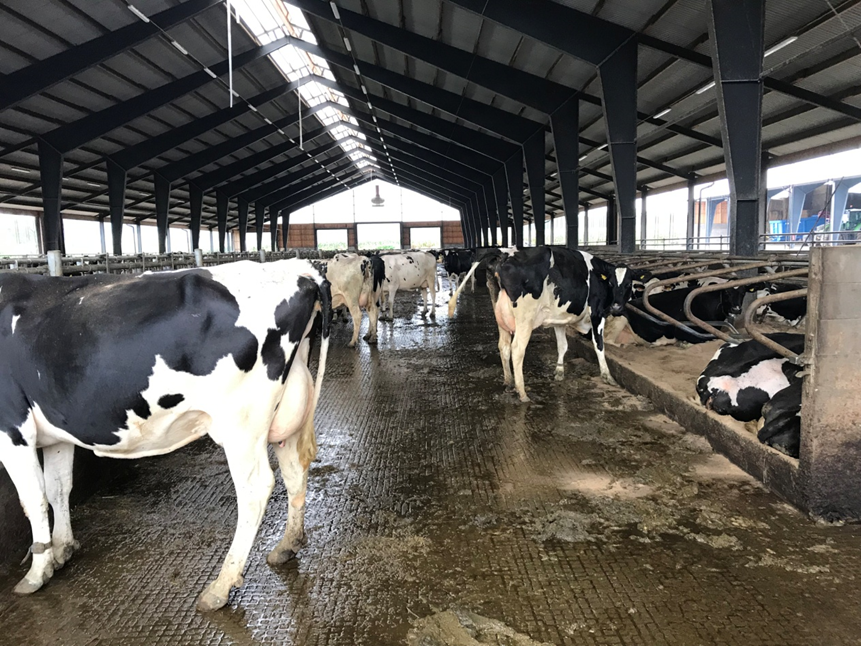News
Herd Health Decisions and Tasks for the Dry Period
In the Autumn, the Munster Bovine Herd health vets have one to one meetings with over 1,000 farmers. The discussion is wide ranging from EBI and cow suitability, nutrition, infectious disease, cell count management, calf health and lameness. This year there are some common threads around cow management that kept coming to the fore; energy balance in early lactation, calf dosing, coughing cows and the ongoing issue of mastitis and SCC.
The ongoing battle to get enough quality dry matter into cows
Spring 2023 was late for most herds and there was a drop in milk production as cows stayed in longer in March. It reinforces the point that early lactation feeding will drive production, body condition and health for the season. Feed quality in February and March is a major challenge. Silage quality is variable and as milk solids production genetics improve year on year in herds, the energy demand of fresh cows is increasing. It begs the question if farm systems are robust enough to feed fresh cows well if they can’t access enough grass in the early part of the year.
The most common manifestation of poor energy intake in early lactation is lower than expected protein percentages and when reviewed, a drop of up to 10% in first service conception rates.
During the herd health meetings, the nutrition reports that review the milk production data from the early recordings can reveal significant energy balance risks in early lactation. While low protein %’s are indicative of poor energy intake, it is common that the top 20% of cows in herds are yielding more than 35 kgs of milk in March/ April. These fresh cows have a limited intake capacity and only get to their maximum feed intake at 50-70 days after calving. To compensate for lower feed intake the cow must use her body reserves. While for most cows this is not detrimental as they catch up pre-breeding, a proportion of cows have lower first service conception rates, and the six-week in-calf rate will drag. The goal is to ensure that >70% of the mature cows continue to calve in the six-week window.
Using a rule of thumb, a cow of 550 kgs body weight producing 2.3 kgs of milk solids needs approx. 6 UFL (energy units) for maintenance, and 6 UFL for every kg of milk solids produced. This is ~20 UFL needed to allow the cow to function without weight loss. This means that the cow must consume a minimum of 21 kgs high quality feed daily in early spring!
Continued on-farm limitations to feed intake include both a lack of cubicle and feed space. For fresh cows, the need for one feed space per cow to ensure that all cows get enough dry matter cannot be underestimated.
Another limiting factor is getting the balance right between enough dry matter offered in the paddock and the residual being hit. The stripwire has an important function but on farms where the genetic merit of the cows and high milk production sub-index drives feed intake, there is a risk that a proportion of cows in the herd are not getting enough dry matter in 12-hour grazings. It becomes more acute as the season progresses and the deficiency in dry matter is often reflected in lower 1st service conception rates in older higher yielding cows.
On some farms, it is reflected in poorer fertility and production performance of 1st lactation cows. A useful figure to consider is checking from the milk recording if the 1st lactation cows are producing at least 78% of the mature cows (3rd lactation) at peak. So, check out the yield in an April/May recording and see where the 1st lac are at. If they are underproducing, it may be as a result of competition for dry matter.
In some cases, it goes right back to the calf history. Herds that battle with pneumonia with the young stock can struggle to have 1st lactation heifers that perform well enough. You will always have super performers, but what percentage of the group overall is lagging? Once 20% of the group is consistently underperforming, then there is likely to be an issue with heifer growth rates and persistency in the herd.
The take home message is to do everything to ensure high feed intake in early lactation for all cows. This may include using second forages to supplement silage if the cows have limited grass access due to poor conditions in March/April. Or it may be as simple of ensuring the daily grass dry matter allowance is increased to accommodate higher dry matter intake demand.
SCC is not going away
Cell count is proving to be a stubborn issue on many farms and contagious mastitis bacteria (Staph. aureus) are showing up repeatedly, leading to high cow cull rates and a struggle to keep below 200 in the tank. Only for high fertility rates in herds, the rate of cow loss to cell count would be unacceptable. We are fortunate in most herds to have room to cull.
The same issues keep turning up:
• More teat dip/spray post milking needed.
• Teat end damage as a result of poor machine performance.
• Not using the milk recordings to find problem cows and not drying off problem quarters.
• Overuse of antibiotics and non-antibiotic treatments in cows that are incurable due to age, persistent cell count and bacteria type. These cows remain as chronics in the herd infecting other cows.
• Contagious bacteria spreading during milking.
• Overreliance on the dry cow antibiotic to solve problems.
• Farmers overwhelmed by work and finding it tough to keep on top of everything particularly parlour, cubicle and cow hygiene.
The herd health meetings give the opportunity to forensically examine the milk recordings and look for the trends on the farm.
Bulk tank SCC can vary from recorded SCC in some herds, and this creates confusion regarding the accuracy of individual cows’ SCC. The milk recording is a single test from one milking, 95% of which are taken from the evening milking when volume is lower. The Bulk tank SCC is an average result from 4-6 milkings and is influenced by the individual cow yields over that period. The percentage or proportion of the effect on the tank result or the milk recording result is yield dependent. We tend to only look at the top five cows, but it is reckless to cull a cow based on one high test due to the variation in a cow’s individual SCC result from day to day. The trend of infection in individuals is most important including looking back at the previous lactation averages and number of tests over 200.
Also, some cows will have a very high result in a single milk recording and have no clinical signs. On CMT tests they may be negative. CMT is sensitive to milk that is over 500,000 cells per ml so it will not pick up quarters below this. However, if the CMT is positive you are guaranteed the cow will have a high cell count in that quarter.
Environmental infections will cause sudden and intermittent spikes in cell count in individual cows. So, it is most important that a single result from a milk recording is not taken in isolation. Check the cow with CMT and see if she requires treatment. If there is no indication that a treatment is needed, then look at her trend and see if she has been an offender in the past before deciding her fate.
Reducing dosing in calves needs vigilance and quick reactions to clinical signs of worms.
There is great interest and acknowledgment of dosing resistance and there has been a reduction of the numbers of dosing events happening on farms. If you are reducing the number of dosing events, you must be extra vigilant. There have been numerous outbreaks of scour and coughing at grass in groups of calves this summer and autumn. If left untreated, calves will scour badly and can die. Also, calves should be dosed at first cough as they will have had lungworm for 10-15 days at that stage and will need an urgent treatment to avoid serious illness and possibly death.
Dung samples are used as a guide to worm burdens. In our experience at the herd health meetings dung samples are taken too few and far between and may not be representative of the group. Also, unless lungworm is advanced in the group, dung samples will be negative for lungworm while a problem is arising. In the ideal world, animals with poorer thrive than their comrades should be dosed to reduce the amount of dose used and the weigh scales is probably the best judge of parasite burdens. Calves should grow on average > 0.7 kgs per day during the season to hit their target weights.
So, if reducing your overall dosing events, you must herd the calves well, consider weighing them frequently to identify the poor doers, and be vigilant for outbreaks of disease. Remember common things are common and the most likely cause of scour or coughing at grass is parasite burdens.
Coughing cows at grass equals lungworm
There are rare cases of outbreaks of viral disease such as RSV and PI3 in cows at grass. Sometimes IBR can raise its head. There are a few herds where mycoplasma problems or tick-borne fever can cause coughing. In the majority of these cases cows are sick and need a treatment with antibiotics and anti-inflammatories. Quite often these problems are triggered by lungworm.
The most common cause of coughing cows at grass is lungworm. Rapid intervention with eprinomectin is our only line of treatment.
The herd health vets have discussed and implemented a lungworm vaccine in some problem herds where lungworm has persisted every year and cows ended up getting multiple doses in the grazing season. The vaccine has been successful in these cases.
The rule is, in herds with chronic coughing and pneumonia issues – get your vet involved, get lung washes done and don’t waste a dead cow – get a post mortem done. Most cases can be dealt with using a good dosing plan, but some herds will need vaccination for lungworm and/or vaccination for RSV/PI3, Pasteurella or Histophilus when pneumonia is persisting.
Finally…
Herds are larger, highly stocked, and in many cases under nutrition pressure due to weather during the season. If the vet’s bills are mounting, and infertility and disease are becoming more and more of a challenge, review your system.
Have you the right cow for the system?
Is the environment you have built around her good enough?
Is your grass management and indoor feeding fit for purpose?
And above all is there enough time in your day for the cows and yourself?
Related Articles
Achieving Your Breeding and Fertility Goals - Milk Matters April 2024

Herd Health Decisions and Tasks for the Dry Period

Munster Bovine Launches New Website

Successful Cow Housing System Guide
